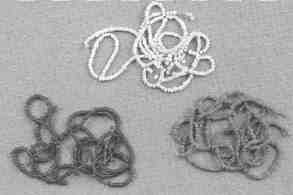
Photograph courtesy of Illinois State Museum
VETO SESSION PREVIEW
Backers of religious
freedom bill weigh options
It is not often that ideologically opposite state
Reps. Lauren Beth Gash and Peter Roskam
agree on an issue. Nor do the American
Civil Liberties Union and the Christian Coalition
frequently back the same cause. Just as rare is the piece
of legislation that passes through both chambers of the
General Assembly without igniting a single lawmaker's
dissent. But making the right to freedom of religion
a state law was that issue.
The Illinois Religious Freedom Restoration Act had to get all the way to Gov. Jim Edgar's desk before it faced a serious obstacle. There, by slipping in a modification with his amendatory veto, Edgar gave those disparate voices something to argue about.
The argument is about how the bill's supporters should respond to the governor's revision, which excludes prison inmates from the law's provisions on the grounds they might use religious meetings as a ruse for such activities as gang gatherings.
"I was disappointed with the governor's changes and all of the members of the coalition are evaluating their positions and trying to find some way to maintain the integrity of the bill," says Roskam, a Republican from Wheaton.
The coalition that lobbied for the bill (which includes more than two dozen civil rights and religious organizations) has been unable to agree on what to do next. It can either accept the bill as it stands, with Edgar's changes. Or, it can use the upcoming veto session to fight to keep the bill in its original form, says
Highland Park Democrat Gash, the bill's chief sponsor.
The religious freedom issue first emerged last year when the U.S. Supreme Court ruled that a federal religious freedom act could not be enforced at the state level and that it would be more appropriately handled by state governments.
The move to handle the issue in Illinois is now in jeopardy. And the coalition doesn't have much time to make its decision. The legislature is set to be in veto session several days this month and next. There are actually three choices for the bill: accept the governor's changes, seek a three-fifths majority to override his action or simply let the bill die.
Edgar also vetoed a bill that would have prevented the state from paying for abortions for low-income women unless the mother's life is threatened by the pregnancy. An attempt to override the veto may occur, though it appears unlikely that opponents have the votes to to do that. There could also be a move to consider new legislation, including proposals on mega-hog farms and nursing homes.
Maureen Foertsch McKinney
WEB SITE OF THE MONTH
The virtual dirt on
Illinois agriculture
Fewer than three out of a hundred Illinoisans still guide a combine by the light of a
Harvest Moon, but one in six of
us makes a living from a food-related
industry. And all of us eat.
So if you'd like to know more about the state's agricultural industry, start i with the Illinois Department of Agriculture at www.agr.state.il.us. Under General Information, a category called "Facts about Illinois Agriculture" gives a brief overview of the state's agricultural production and how it adds to the state's economy. You'll also find updates on the department's programs and services, a kid's page, links to other state and federal ag-related sites, and even a page about the Asian Long-Horned? Beetle.
Looking for pure stats and crop reports? Go to the Agricultural Statistics Service's web site at www.agr.state. il..us/agstats.htm. You'll get USDA reports minutes after they are issued. The site also provides the Illinois Farm Report, crop progress reports and a census of agriculture, as well as links to other statistical and market sites.
Illinois Ag Director Becky Doyle is the president-elect of the National Association of State Departments of Agriculture. And the national association has stuffed its site (www.nasdahq.org/nasda/nasda/indexl .htm) with information, including status reports of farm bills introduced in Congress, There is also information about next May's food export show at Chicago's McCormick Place. The show attracts more than 6, 000 buyers from around the world.
Thanksgiving's cornucopia is overflowing — or is it? With these web sites,
accurate ag information is just a few clicks away.
Beverley Scobell
8 ¦ November 1998 Illinois Issues
Honoring ancestors
The state was named after them, the Illiniwek. They were a confederation of as many as 12 tribes that made up the "tribe of men" who
traded with French explorers in the 17th century. Now the Peoria Tribe
of Indians of Oklahoma, descendants of the Illini, have claimed the
remains of 117 ancestors and buried them in their tribal cemetery near Miami,
Okla.
Until the end of September, the remains had been kept at the Illinois State Museum in Springfield. They were uncovered at eight archaeological sites in the state, mostly in southern Illinois, over the last five decades. The museum will keen 32.000 artifacts found buried with the Illini, ranging from traditional pots and arrowheads to such French trade goods as glass beads, silver crosses and brass bells.
"The Peoria Tribe wanted us to keep the artifacts to try to preserve their heritage," says Robert Warren, associate curator of anthropology at the museum. He says so much of its cultural heritage was lost as the tribes' populations decreased dramatically due to warfare and disease. They were probably 10, 000 strong in the 1600s, and by the time they left the state for Oklahoma in the 19th century, Warren says, they were reduced to one tribe of perhaps 300.

Photograph courtesy of Illinois State Museum
The Peoria Tribe of Indians of Oklahoma claimed the remains of 117 of its Illiniwek ancestors from the collection of the Illinois State Museum. But it has asked the museum to keep such artifacts as these beads obtained in trade from French explorers.
The museum listed the remains — some of which are complete or nearly complete skeletons, others a single bone — in the Federal Register in September 1997. Under the 1990 Native American Graves Protection and Repatriation Act, the museum is required to offer the remains to the descendant tribe. The museum also has identifiable remains of other American Indians. Descendants of the Sioux, Cheyenne, Chumash and Cherokee tribes have been contacted, and some of those also plan to claim the remains of members of their ancestral tribes.
Beverley Scobell
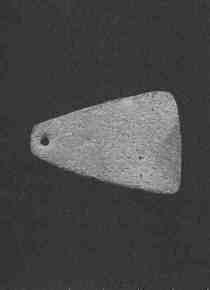
Photograph courtesy of Illinois State Museum
The Illini fashioned trade beads into such decorative items as this pendant.
Candidates got free air time for direct answers
Only had a minute? Maybe that's all
it took to make up your mind about
which gubernatorial or U.S. Senate
candidate to support.
The Illinois Broadcasters Association gave ballot-certified gubernatorial and Senate candidates free radio and television time in the form of five one- minute opportunities to answer specific questions posed by the association. The broadcasters produced the segments last month and distributed them to 53 radio and 12 television member- stations that could run the tapes as part of news broadcasts right up to the November 3 election.
Former journalist and U.S. Sen. Paul Simon, who now directs the Southern Illinois Public Policy Institute, encouraged the association's initiative. "Any candidate should welcome it [the free air time]," said Simon. "If the candidates don't do this, the media ought to get on them." According to Broadcasters Association Vice President Wally Gair, Republican candidates George Ryan and Peter Fitzgerald did not take the association up on its freebie.
Gair said the segments were solely for the public's advantage. "We aren't doing this for the candidates." The association's printed rules prohibited rambling attacks: "If any candidate deviates from the question or begins to attack his or her opponent, the camera will stop and they will be asked to start again and answer the question directly."
The gubernatorial segments included questions on education funding, health care, gun control and campaign finance reform. Questions for the Senate candidates focused on Social Security, flat taxes, foreign policy, fast track trade negotiation rights for the president and "partial-birth" abortion.
The 12 television stations that agreed to pick up the segments broadcast to all the state's major markets except Chicago. The Chicago stations were committed to working toward televised debates, said Gair.
Rodd Whelpley
Illinois Issues November 1998 ¦ 9
BRIEFLY
TEACHERS' UNION SUPPORT FOR RYAN RAISES QUESTIONS
Who benefits from political endorsements?
Joshua Carter was the
first to jump on the Web to
complain.
The day after the Illinois Education Association, the state's largest teachers' union with 98, 000 members, endorsed George Ryan for governor over educator/Congressman Glenn Poshard, Carter posted a scathing note on the association's web site: "As the son of two lifelong educators, I must tell you the idea that the organization would endorse George Ryan is absolutely sickening to me." The University of Illinois law student and substitute teacher concluded: "Backing candidates who are most likely to win is more important to the TEA than candidates who actually support education in Illinois. All I can say is you get what you deserve and you have lost the sympathy of one of your former supporters."
In fact, looking at the issue in practical rather than philosophical terms, it may be more beneficial to an organization to support the candidate it feels is most likely to win. For the group handing out endorsements and support (in the Illinois Education Association's case, that includes volunteer power and financing), there are many factors to consider in addition to pleasing its own members, notes Jack Van Der Slik, director of the Legislative Studies Center at the University of Illinois at Springfield. "To the organization, it's saying, 'You're our guy and down the road we will expect you to remember that and we expect that you will look sympathetically on our causes.'"
In 1994, when the education association gave $400, 000 to Democrat Dawn Clark Netsch, who had a well- defined plan to reform school funding, there was little to be had for the organization in the bargain. What the association (and rival teachers' union, the Illinois Federation of Teachers) received in return for its endorsement efforts was a frosty relationship with returning Gov. Jim Edgar.
Nevertheless, teachers' federation spokeswoman Gail Purkey warns there is a price to pay for a warmer, cozier relationship. Her union would not endorse Ryan because his record doesn't merit it, she says. "When you tailor your endorsement to who's going to win rather than where you stand, what does that say about your organization and what it stands for?"
And not following the wishes of the membership can hurt the organization. "In the long run, if people feel the endorsements being made are not in their best interests, then it's hard to keep their allegiance and that makes it difficult to have an effective organization," says Henry Bayer, executive director of the American Federation of State, County and Municipal Employees Council 31.
But the Illinois Education Association leadership notes that Ryan — who during his tenure as a lawmaker took a pass on many union initiatives, including collective bargaining — does appear to be the choice of its members. "Our random survey shows the preference was 55 percent to 39 percent among our members," says George King, director of communication for the education association.
But those members who oppose the endorsement are vocal. Aldo Migone, a Southern Illinois University physics professor, is demanding the return of the $20 share of his dues that funds the union's political action committee. "It's a matter of principal, and I'm going to keep asking for my $20 back until they become a little more democratic," he says.
Jennifer Davis
10 ¦ November 1998 Illinois Issues
Photo falls flat with voters and bidders
Abraham Lincoln? Hah! We need
more evidence to cast aside
qualms, particularly those
shaped by dubious historical
claims and contradictory scientific data.
So said visitors to the Old State Capitol who were asked to vote on the authenticity of a daguerreotype that some claim is the earliest photographic image of Lincoln. Beside the display of a copy of the photograph was a ballot box — really an overturned top hat. By an overwhelming margin (1, 452 no to 497 yes), voters said they did not believe the face staring up from the copy of the 3 l/2-inch-by-3-inch daguerreotype was that of the Great Emancipator. The votes were tallied the day before the actual daguerreotype was to be auctioned at Christie's in New York.
As Lincoln would say, you can fool some of the people some of the time. But the voters' message to Christie's bidders was: This picture is not worth a six-figure sum.
Indeed, buyers were not sufficiently impressed with a "Portrait of a Gentleman Believed to be Abraham Lincoln, Age 34." At the October 6 auction, the $150, 000 high bid was below the undisclosed minimum the owners had set, and the item remained unsold.
To put the potential value of a photograph in perspective, Christie's holds the record for taking the highest bid for any photo. Alfred Stieglitz's 1920 photo of his lover "Georgia O'Keeffe: A Portrait — Hands with Thimble" sold in 1993 for $398, 500. (Of course, no one ever doubted that the photo's subject was the artist Georgia O'Keeffe.) Christie's admits the man who might be Abe has a nose that looks big and eyes and hair that seem light. But in press materials they blame it on the "distortion of the early lens."
Efforts to establish the authenticity of the Lincoln photograph are not new, but word of the auction whipped up the controversy.
Illinois State Historian Thomas F. Schwartz — who described Christie's pre-auction estimate of $200, 000 to $300, 000 as "an outrageous sum with a questionable photograph" — first learned of the attention-grabbing picture back in 1994 when New York Lincoln memorabilia collectors Joan and Robert Hoffman acquired it.
It was an interesting notion for a scholar of Illinois history: If genuine, this would be the earliest existing photograph of the man who saved the union.
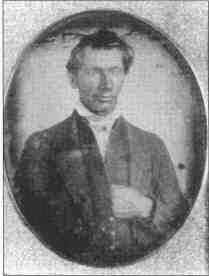
Photograph courtesy of the Hoffman family and the Illinois State Historical Library
"When the photograph first surfaced a number of years ago, we were contacted both by the owner and the dealer who had been promoting the image as Lincoln. I asked them what's the provenance [the history of ownership]? They didn't have one." Schwartz was told the daguerreotype had belonged to Alice Hay Wadsworth, the daughter of John Milton Hay, who had been a secretary to Lincoln. "And my question was why would the president give the earliest image of himself to his secretary," Schwartz says.
Schwartz has a long list of reasons why he doesn't think the man in the picture is Abraham Lincoln. Among them: Scholars note that Lincoln's son Robert insisted that he knew the earliest photograph of his father — a picture that now belongs to the Library of Congress. "Robert remembered seeing that image in the Springfield house when he was growing up."
If the scruffily-clad photo was of Lincoln, Schwartz notes, the image was taken without Mary Todd Lincoln's knowledge and without Lincoln "even having his best dress on."
And, says Schwartz, if the picture is of Lincoln, why didn't Hay ever use it for publication?
Christie's — though never actually claiming the picture is of Lincoln — points to a series of scientific tests that would appear to indicate he is the man in the photo, including Lewis Sadler's mathematical analysis of the facial dimensions in the daguerreotype. Sadie is the chairman of the biomedical visualization department at the University of Illinois at Chicago.
"You can pay for expert testimony as much to obfuscate as to clarify," Schwartz says, noting that several other tests appear to disprove Lincoln was the subject.
But the notion that the picture might be Lincoln makes it valuable, says Rick Wester, a vice president at Christie's who is in charge of the photographic division. "I think the interest is based on the fact it could be him," he says. "That is a very exciting prospect. Add to that what we do know. Whoever the person is, photography is only four years old at the time the picture would have been taken." According to Wester. the picture can be dated back to "1842 or 1843 based on quality and presentation."
In that period, Lincoln was an Illinois lawyer and member of the state House of Representatives. Today, the building where the House met, the Old State Capitol, is a historic site. People visit because it is a place where the man who would become the 16th president once stood. It is a place frequented by those who know Lincoln, or at least his image, well, says state historical librarian Kirn Bauer, who came up with the idea for the vote.
It is the people, he says, who are best
equipped to judge a face. But, he laugh
the "people" are contradictory just like
the experts. One ballot voted against the
image being Lincoln: "It's the ear-lobe.
Earlobes don't lie." Five or six ballots
later someone said: "Yes. It's him. It's
the earlobes."
Maureen Foertsch McKimey
Illinois Issues November 1998 ¦ 11
BRIEFLY
One-punch punched out
Shortly before the election, Carbondale
attorney John Womick filed suit in state
and federal courts challenging the state's
ban on one-punch, straight-party voting
on the basis that barring the option
discriminates against poor black readers.
A Republican-led General Assembly passed the law prohibiting the one-punch, straight-party vote in the waning hours of the legislative session immediately following the 1996 general election. Straight- party voting initiatives, such as Cook County's 1996 "Punch 10" campaign, aided the Democrats, who regained the majority in the House starting in January 1997.
Womick isn't the first to challenge the law. But in October, the state Supreme Court refused to hear an appeal of a lower court's ruling that upheld the one- punch prohibition. One of the bases for that challenge was that the bill improperly passed through the legislature because it was not read on three different days in each house of the General Assembly.
Beverley Scobell
Keeping tabs on sex offenders
The U.S. Department of Justice has awarded the Illinois State Police's
Intelligence Bureau a $680, 000 grant to keep track of sex offenders.
Specifically, the grant comes through the justice department's National
Sex Offender Registry Assistance Program to the Illinois Criminal Justice Information Authority. The funds will allow the authority to assist the State Police in transmitting information to the FBI's permanent sex offender registry when it comes online in October 1999.
Currently, authorities have identified more than 14, 900 persons who are required to register, and have entered relevant information on them in the Illinois Law Enforcement Agencies Data System. Of those, more than 11, 800 are registered sex offenders. Mug shots are part of the registry, but the new money will enable the police to digitize the photos for electronic transmission.
The grant money will also enable the State Police to review county databases and files to identify records of previously convicted individuals who are not entered in the registry. Cook County alone has records of more than 2, 700 sex offenders who must be entered.
Beverley Scobell
NOTHING IN THE WORKS. SAYS COMMISSION CHAIR
Yet time could be right for state
workers to get early retirement
State employees are looking to the skies for signs of golden parachutes.
At least the early indications are right for manna from above: Gov. Jim Edgar leaves office in January; a plethora of departures would let his successor shape his own staff; Edgar's departure insulates the office from the heat created by a huge expense. Now it would appear all that's in the way of an early retirement incentive for state workers is the General Assembly, which meets for its fall veto session this month and next.
"My guess is it would make things easier for a new governor," says Republican Sen. Larry Bomke of Springfield. "Based on that, I think there's a possibility something's going to happen with it."
But wait. Bomke, who says he would be open to a package depending on cost, notes that it's up to the bipartisan Pension Laws Commission whether to bring a retirement incentive proposal before the legislature.
Commission co-chairman Sen. John W. Maitland Jr. says so far he sees no reason to consider an incentive, which could cost as much as $600 million. "Nobody in power, neither the governor nor the Senate president, has to said to me, 'Well John, we're going to do this,' and I'm not sure how I would respond if they did," says Maitland, a Bloomington Republican. "If you're not saving money, if you're not downsizing, why are you trying to get people to retire early?"
Back in 1991, when Edgar was first inaugurated, an early retirement incentive proposal was enacted to cut staff size during a budget crunch. It cost $500 million, but savings were never calculated, commission Executive Director Patricia Stevens says. Now there are about 17, 000 workers over 50 who would be eligible if the legislature were to enact a retirement incentive package similar to the 1991 plan, which gave workers with five years of pension-covered service the chance to buy credit for five more.
Robert Knox, a State Employees Retirement System official, says he has been getting up to a dozen calls a week asking him whether an early retirement incentive deal will come up in the legislature's fall session. But Stevens says she believes wide-spread rumors that a plan may be on the horizon are the result of some of those 17, 000 potentially eligible workers engaging in "wishful thinking."
Maureen Foertsch McKinney
12 ¦ November 1998 Illinois Issues
Q&A Question & Answer
Thomas Emerson
The Illinois Historic Preservation
Agency has launched a two-year traveling
exhibit on the Grand Village of the Illinois
tribes. The village was erected across from
what is now known as Starved Rock. The
exhibit highlights the first Grand Village
meeting between Europeans and Indians,
though it includes descriptions of the daily
lives of the people who lived in the area for
hundreds of years. The exhibition is based
on the many archaeological excavations of
the Grand Village since 1947. Thomas
Emerson, now with the University of
Illinois at Urbana-Champaign, was the
state's chief archaeologist for 10 years. He
was responsible for mapping the site after
the state purchased it in 1991.
Q. What did you know about the
Illini before you started?
The Illini are one of the better documented tribes in the Midwest, primarily
because the French were so interested in
them as political allies. But these [documents] were written by people who had
other agendas, so we have to pick up
information almost accidentally. What
we knew was that the Grand Village was
the largest grouping of Indians in the
Midwest during the late 1600s. It
stretched along the Illinois River for at
least three miles, was discussed as being
half a mile wide, and included anywhere
from a few thousand people to over
10, 000. We knew the Illini lived in long
houses. They were farmers. They went on
large-scale buffalo hunts during certain
portions of the year. While this was their
major village, in the winter they would
break into smaller groups and spread all
over the state.
Q.What was the time period?
The Grand Village as an entity in
history really comes together in 1673. In
Illinois, this is the place where history and
prehistory meet. This is where Marquette
and Jolliet for the first time in Illinois
meet the Illini. From that point, the life of
the Grand Village really is fairly short. In the 1690s it was being abandoned
because of pressure from Iroquois war
parties and from northern groups who
were attacking the village. And so the
whole group moved south into the Peoria
area. But the Grand Village as a place
where Native Americans lived has a
history that starts really about 800 A.D.
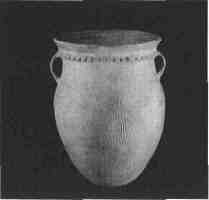
Kelvin Sampson of the Dickson Mounds
Museum made this ceramic replica of an Illini
Indian cooking jar. The vessel is part of the
state's Grand Village traveling exhibit. The
photograph comes to us courtesy of the Illinois
Transportation Archaeological Research
Program, which produced the exhibit.
Q. How did the French affect the culture of the Illini?
We know from the historical record
that the Illini were very interested in getting material goods from the French. We
simply haven't found them at the site. We
looked at French trade records, and it
became very clear that the kind of material items that were coming in were
designed for women. The primary item of
trade, in fact, was cloth. And that is followed very quickly by things like metal
needles, metal axes, brass cooking pots. It
really was kind of a kitchen revolution, I
think, when the French moved into the
area. It is possible trade items were so
precious they were used into nonexistence. And we were not attempting to do
large-scale excavations. So [not finding
the items]... may be simply a sampling
issue.
Q. What kind of things did you find?
The dominant things that archaeologists find are rocks and ceramics because
they preserve the best. We were looking
for fragments of brass kettles, for beads.
Seed beads, very tiny glass beads, are one
of the dominant things that were traded
to the early Illini. And they were fairly
common at the site. Musket balls. Flints
from flintlock rifles. But generally the
flakes that remain from making stone
tools and ceramic pottery vessels are the
most obvious things we were looking for
on the surface. And those were the things
that were most concentrated in that strip.
The other thing we were very concerned
about was getting below the surface in
some areas to determine what the density
of the material is at the site. So we did a
whole series of excavations along the current river line to see what kind of material
was being eroded away. We did demonstrate with our subsurface testing that the
Illini presence is there and that it's very
much like the French portrayed it.
Q. What happens next at the site?
It is, from my perspective, one of the
premier sites in Illinois for the interpretation of the historic Indian groups. We
have lots of state historic sites — a lot of
them deal with European groups, a lot
of them deal with prehistory — but
there is really not a site that focuses on
the Illini and their importance, or the
importance of the historic Indian period. The site also — being at Starved
Rock — is in an area that's one of the
most heavily visited in the state. So we
have recommended that the site have
some kind of interpretive facility and
that it be made open to the public. It's a
spectacular site, a spectacular view, and
a really important site in Illinois history.
You can find out more about the Grand Village, or the traveling exhibit, by contacting the Illinois Historic Preservation Agency in Springfield.
Peggy Boyer Long
Illinois Issues November 1998 ¦ 13
BRIEFLY
Illinois' largest employer is Illinois
The state of Illinois and branches of the federal and local governments are six
of the top 10 enterprises issuing checks to Illinois workers. That's the finding of the
Department of Commerce and Community Affairs' search for the state's largest
employers. This isn't new. The first 10 slots on the department's 1998 list of the 32 top
employers are occupied by the same organizations that headed the department's last
listing in 1996.
But, according to department spokesperson Larry Michaud, the findings don't necessarily reflect an economy that depends too heavily on public-sector jobs. In fact, statistics from the 1997-98 edition of The State and Metropolitan Area Data Book indicate that a smaller-than-average percentage of Illinois' workforce draws a pay- check from the government. Nationally, 19.4 percent of working Americans hold down government jobs. The rate in Illinois is 16.6 percent.
Top 10 in-state employers
|
Employer |
Employees |
|
1. State of Illinois (excluding universities) |
82, 400 |
|
2. U.S. government (excluding Post Office) |
52, 200 |
|
3. Chicago School Board |
48, 000 |
|
4. Post Office |
45, 800 |
|
5. City of Chicago |
41, 800 |
|
6. Jewel/Osco |
37, 900 |
|
7. Caterpillar |
31, 300 |
|
8. Cook County |
27, 400 |
|
9. Motorola |
25, 000 |
|
10.Wal-Mart |
24, 000 |
|
Source: Illinois Economic Bulletin, Vol. 11, no. 2, August 1998. |
|
Rodd Whelpley
Time Capsule
In Illinois politics,
it's deja vu all
over again
On his second day as
secretary of state, Jim
Edgar discovered he had inherited a license-selling scandal in his Chicago office. It seems several dozen people were involved in kickbacks in the issuance of driver's licenses.
"We moved as quickly as we could," Edgar said on public television. "We had to have evidence. By taking quick action, we've sent a message that we're not going to tolerate dishonesty any longer in the secretary of state's office, and we will move as quickly, as forcefully as we can when we uncover that. I won't say that all illegal activities are removed. I don't think those things change overnight. But I do think we're on the right road to clearing up those things. 5 5
Edgar also inherited an office full of Democratic activists from previous administrations, including 20 county chairmen. One of those, Earl Smock of Hoopeston, the chairman of the Vermilion County Democratic Central Committee, was accused of doing political work on state time and was dismissed.
Illinois Issues, September 1981, from an article by Al Manning
14 ¦ November 1998 Illinois Issues
Springfield Colored Home on national historic register
It's official. Springfield has one
more site in its history-rich
community. The National
Park Service added Donald
Kren's square brick fixer-upper to the
National
Register of
Historic Places
after it was
discovered
that his house
served as the
city's, and
possibly the
state's, first
orphanage for
black children.
Kren bought the house for $15, 000 as an investment opportunity. He thought it was well-built and his original plans were flexible. He had no idea the building had a significant historic value until he discovered a cornerstone with the words, "Lincoln Colored Home, Established 1898, Rebuilt 1904."
Kren credits the efforts of Carl Madison and Barb Dickerman and other NAACP members for successfully establishing the home on the local and national registers. Madison explains: "The historical significance of the Lincoln Colored Home was important because it showed cooperation between blacks and whites."
According to Dickerman's research, Eva Carroll Monroe, a Kewanee native, established the orphanage in 1898 with the help of some of Springfield's high society women. The
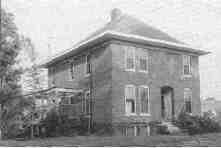
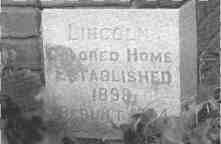
Photographs by Randy Squires
Lincoln Colored Home served black orphans and some elderly people until the 1930s. At one time it was home to more than 40 orphans and elderly people.
Ann Swallow, the National Register coordinator for the Illinois Historic Preservation Agency, cited the home's importance:
"This was the first orphanage in Springfield for African- American children. It was the first orphanage building to be listed on the National Register."
Kren plans to continue working with the NAACP, which plans to form a not-for-profit foundation to raise money for the home's restoration.
Cindy Ladage
Illinois Issues November 1998 ¦ 15
|
Sam S. Manivong, Illinois Periodicals Online Coordinator Illinois Periodicals Online (IPO) is a digital imaging project at the Northern Illinois University Libraries funded by the Illinois State Library |